These volcanic hot springs trace the origins of humanity
Ethiopia's Dallol sulphur springs are nestled in a Mars-like red dessert which humankind's oldest ancestors once called home
Ethiopia's Dallol sulphur springs are nestled in a Mars-like red dessert which humankind's oldest ancestors once called home
Welcome to Wanderlust Wonders: each week we’ll be cleansing your feed with a feel-good snapshot of somewhere beautiful, both in and out of this world.
What am I looking at?
These otherworldly hot springs in northern Ethiopia are located in a desert that's among the driest and hottest places on Earth. But despite the fact it's essentially inhospitable to humans, it attracts a fair share of tourists due to its mesmerising, Mars-like landscape filled with colourful acidic springs and lava craters.
The hot springs are just one part of the red desert known as the Danakil Depression. The terrain holds other natural wonders like active volcanoes and pockets of small salt ponds that keen explorers seek out thanks to their extreme buoyancy (it is the saltiest body of water on the planet!) Visitors are not encouraged to stay long, however, as the extreme heat and sulphuric fumes can be hard for our fickle human bodies to hack.
Tell me more…
The Danakil Depression is the result of a game-changing period in the planet's history: the splitting of the continents of Africa and Asia due to the movements of the tectonic plates. Now, the area sits atop the meeting point for three tectonic plates, which is why there is so much volcanic activity.
Danakil is one of the lowest points in the world, resting at 100 metres below sea level. It's also flanked by two historic and active volcanoes; Mount Aleyu, the elder of the two, and Erta Ale, which spurts lava from the earth’s mantle.
Often referred to as "the cradle of humanity" by geologists, this was where Lucy, the oldest known remains of a hominid, was discovered in 1974. How old was this human ancestor? Very, very old at 3.2 million years old. Who knows what other mysteries lie beneath this unique terrain...
Is it under threat, and how can we help it?
Because of the desert’s incompatibility with sustaining human life, tourist activity poses very little threat to this otherworldly place. And scientists are pretty keen to protect it. The hot springs, known as Dallol sulphur springs, are far more than just a picturesque landscape. The natural formations are used by scientists to investigate how life might form on other planets and moons, as the Dallol springs are home to organisms that can live in extreme heat and hostile environments. Maybe its comparison to Mars isn’t so fantastical after all!
As of 2022, the International Union of Geological Sciences has even gone as far as to protect the desert as one of 100 geological heritage sites on our planet. Because of the desert’s volcanic activity and consequent geological biodiversity, the Danakil Depression has been marked as one of the most important places on our planet for the advancement of geological sciences.
Best views from the grid
Tune in next week for another does of visual healing...



